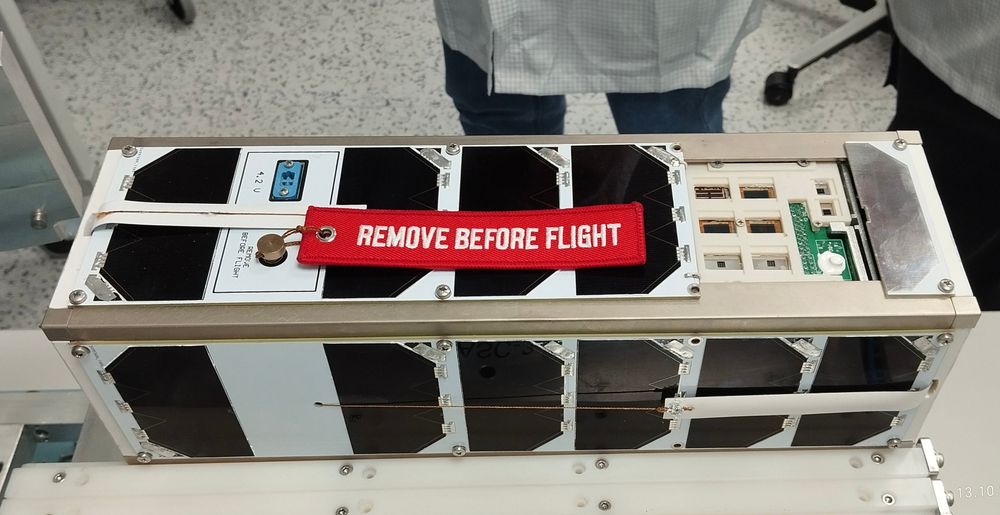- Name
- MORDOVIA-IOT
- Alternate Names
- RS50S
- Satellite ID
- GAHV-9088-5977-7290-0624
- NORAD ID
- 61765
- Website
- https://spacepi.space/satellites/mordoviya-io-t/
- Country of Origin
-
Russia
Satellite is in orbit and operational
Satellite is reported to be transmitting at an uncoordinated or denied frequency. Details

- Launch Date
- 2024-11-04T23:18:40+00:00
The Mordovia-IoT spacecraft (State Budgetary Professional Educational Institution of the Republic of Mordovia, Saransk Polytechnic College) has an IoT (Internet of Things) module developed by schoolchildren. The technology allows, using IoT satellite communications, to receive information from ground-based educational sensors (weather stations, environmental monitoring systems, water level sensors, smart agricultural sensors, SOS signals) and retransmit it back to Earth or store it in the spacecraft’s memory for subsequent reset to Earth. In addition to receiving data from ground-based systems using satellite communications, it is planned to test the control of remote ground devices via satellite.
Description of the IoT relay mission on the satellite: creation of a space infrastructure to support Russian IoT networks. Satellite relay will allow connecting IoT devices in remote and hard-to-reach regions of the Earth where there is no traditional communications infrastructure, including deserts, oceans, mountains and rural areas.
Functions of the IoT repeater module: receiving signals from multiple IoT devices on Earth. After receiving the data, the module transmits it to ground stations for further processing and analysis. The module can partially process the data, such as filtering out important signals or aggregating the information before transmitting it.
Applications:
Agriculture and environmental monitoring: The satellite-supported IoT system can monitor field conditions, water levels, soil moisture, and other parameters in real time, ensuring timely crop care actions; Transportation and logistics: The satellite-based IoT module helps track vehicles, ships, and aircraft around the world, ensuring continuous communication even in the most remote locations; Industrial projects: Devices such as oil platforms, mining stations, and other facilities located in remote areas can transmit their operating data via the satellite-based IoT network; Security and disaster management: The satellite-based IoT communication system can support disaster monitoring, detect hazardous material leaks, and transmit critical data in real time.
Advantages:
global coverage: connecting IoT devices anywhere on Earth; independence from ground infrastructure: no need to build cell towers or lay cables, which is especially important in hard-to-reach places; low latency and high reliability: modern satellite systems provide high data transfer rates and reliable connections, which is critical for some IoT services.
Energy-efficient protocols are used to transmit small data packets, which corresponds to the features of most IoT devices that often send short messages. Thus, the IoT relay module on the satellite will provide global communication for Internet of Things devices, which will open up new opportunities for commercial, scientific and government projects in the most remote regions of the world.
The Mordovia-IoT satellite will operate according to two schemes: data transmission without information processing and data transmission with information processing.
Data transmission without processing: the subscriber (device) on Earth receives a communication channel with the satellite, the satellite at this moment establishes a connection with the base station on Earth, and the subscriber (device) directly retransmits the data to the server on the Internet or to the school receiving station.
Data transmission with processing: the subscriber (device) on Earth receives a communication channel with the satellite and all transmitted information from the subscriber (device) is stored in the internal memory of the satellite and then sent to the base station on Earth and published on the Internet. This method of data transmission is possible in hard-to-reach places on planet Earth. Such a system is relevant in the territory of the Russian Federation, where only 20% of the territory has access to communication systems.
Access to the satellite channel will be open to everyone. This will allow a schoolchild to install a weather station with sensors in a remote location, and then receive data from it using space communications, and monitor the state of the environment in an educational institution or at home.
The Laboratory of New Materials for Solar Energy of the Faculty of Materials Sciences of Lomonosov Moscow State University (LNMSE) will conduct a space experiment on a satellite called "New-generation solar batteries based on hybrid perovskites".
The experiment will study 8 laboratory samples of perovskite solar cells, as well as "control" samples of silicon and three-cascade solar cells (provided by JSC Saturn as part of their cooperation with LNMSE). The developed onboard electronics will record and transmit to Earth data on the current parameters of perovskite solar cells, such as power and efficiency, which will allow for the first time to assess the stability of their instrumental characteristics in space flight conditions in near-Earth orbit.
- Type
- Transmitter
- Service
- Amateur
- Downlink Mode
- LoRa
- Downlink Frequency
- 437865000
- Baud
- 125000
- IARU Coordination
- IARU Uncoordinated
- Type
- Transmitter
- Service
- Amateur
- Downlink Mode
- FSK
- Downlink Frequency
- 435750000
- Baud
- 2400
- IARU Coordination
- IARU Uncoordinated
- Type
- Transmitter
- Downlink Mode
- SSTV
- Downlink Frequency
- 437090000
- IARU Coordination
- IARU Uncoordinated
- Type
- Transmitter
- Service
- Amateur
- Downlink Mode
- AFSK
- Downlink Frequency
- 437100000
- Downlink Drifted
- -9151
- Baud
- 1143
- IARU Coordination
- IARU Uncoordinated
| Observer | Latest Data |
|---|---|
| EU1XX-KO33ru | 2025-12-27 21:17:05 UTC |
- TLE Source
- Space-Track.org
- TLE Updated
- 2025-12-28 09:15:23 UTC
- TLE Set
-
1 61765U 24199AG 25362.11853023 .00243492 00000-0 16215-2 0 9992
2 61765 97.3083 236.4670 0006485 119.1181 241.0734 15.74673592108302